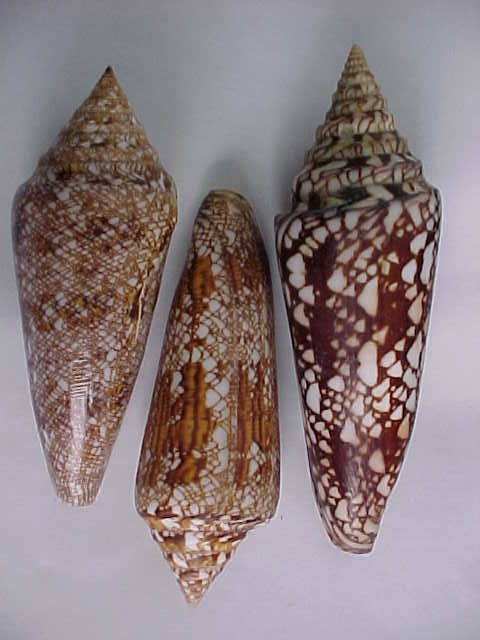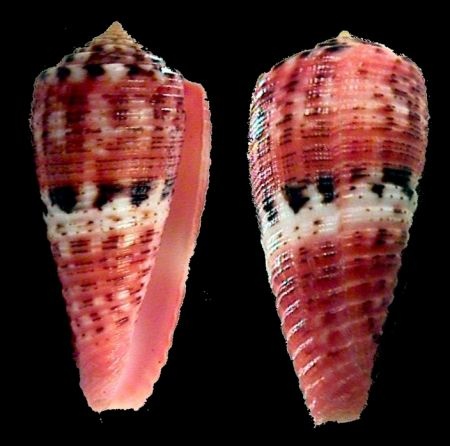|
Cones (Members of the family
Conidae, which is almost completely one genus - Conus,
except for three species belonging to the genus Conopleura)
have long been one of the most collected mollusc families because of
their elegance, beauty and breathtaking variability. There about 650
described species (depending upon whether one is a "lumper"
or a "splitter", taxonomically-speaking......) and many of
these have a wide spectrum of subspecies, varieties, forms and morphs
- described or not (A species or form is given a formal, usually Latinized
name when they are officially "described" in the scientific
literature - so a "described" species, subspecies or variety
is one which has been officially differentiated and named in a publication
in the "mainstream" scientific literature (ie, in a regularly
published journal or supplement, or a book - not a nature club newsletter!)).
They are all hunters by nature
- active carnivores which use harpoon-like radulae ("teeth")
to spear their prey. The harpoon-radulae deliver a dose of powerful
poison which very quickly stop the hapless victims in their tracks,
via paralyzing their nervous systems. In the case of species which prey
on fish (called picsovores), these "neurotoxins" must be extremely
powerful, to prevent the harpooned animal from swimming very far before
they are stopped by the poisons. Thus, they can be harmful or even on
occasion fatal to humans who are unfortunate enough to get stung by
these particular cones (which will be the topic of the NEXT Mollusc
of the Moment...... Killer Cones).
Cones can be found in all
tropical or semi-tropical seas, in habitats ranging from subtidal to
depths of over half a kilometer (1600 feet). They range in adult size
from 7mm to almost 250mm (10 inches), and come in all the colors of
the rainbow and a fantastic range of patterns.
|
|
Over the space of 200 years,
four cones of exceptional beauty have been dubbed the "Glory of"
the various regions where they live. The first was the admittedly very
lovely Conus granulatus described in the ground-breaking
series of books Linneus published in 1758, where he created the modern
system of describing all forms of life on our planet - with the fundamental
moniker for each species being a "binomial" name consisting
of genus and species - see the article on taxonomy for a summary. Anyway,
it soon became known as the "Glory of the Atlantic", and until
the era of SCUBA diving permitted people to find them more easily (although
they have never become common in collections despite the fact that they
are found throughout the West Indies) they were VERY rare indeed. They
are the "odd man out" in the Glory of series of cones, since
the other three are all related very closely and live in the same general
region on the opposite side of the world.
The second was the famed,
fabled "Glory of the Seas" cone, Conus gloriamaris
L., which because of its fabulously intricate "tented" pattern
and great rarity was perhaps the most prized of all shells until 1968,
when divers found out where they live (more info below). They have been
found from Eastern Indonesia to the Solomon Islands, although almost
all of the specimens sold these days come from the Philippines. No "general"
shell collection can be considered half-way decent without an example
of this fabulously famous species.
When Jousseaume, a versatile
"natural historian" (science used to be known as "natural
history" since it is the study of nature), dubbed Conus milneedwardsi
the "Glory of India" when he described it over a hundred years
after the "Glory of the Seas" was introduced to science and
collectors in the "Western" world. It is obviously closely
related to Conus gloriamaris , having the same shape,
being similar in size (just a tad larger: a large specimen will measure
over 160mm, while a similarly large Glory of the Seas cone will only
be 125 to 130mm), and displaying the same kind of pattern, only much
coarser. Conus milneedwardsi Jousseaume (when giving the
formal, scientific name of a species, one should always include the
author of the article in which it was described - this eliminates confusion
regarding which taxa is being referred to: the same name has often been
given by mistake, to different species or forms by different authors
who were unaware of the original name. When this sort of duplication
is discovered, the second species is given a new name, but of course
the old, conflicting name remains in "the literature" (i.e.
the totality of all scientific publications, which are collectively
referred to simply as "the literature") as a source of confusion!!
Therefore, when you include the author as a vital component of the name
of a species or form, you narrow it down to just one publication, eliminating
any possible confusion.) is found in three separate populations usually
regarded as "subspecies" - one ranging from South Africa to
the Red Sea, a second much more limited population found around the
Mauritius Islands and Reunion, and the main bunch lives in relatively
deep (50m to 200m) waters off Western India, Sri Lanka and Pakistan.
A closely related species, kawamamurai Habe 1962, is found
at Ryukyu Island in Southern Japan. Found as part of the "by-catch"
in trawlers in this area, it has recently become extremely common in
collections, since the price has dropped out of the sky in the past
few years (from 2002 to 2005).
The fourth in the series
was surprisingly not formally described until 1968 - i say "surprisingly",
because it is relatively common all throughout the Bay of Bengal, from
Eastern India to Western Thailand, in depths commonly trawled: 50m to
130m. Okutani immediately recognized Conus bengalensis
as being a member of the "Glory of" gang of cones, and accordingly
dubbed it the Glory of Bengal. It is the smallest of the three, with
120mm specimens being very scarce, but is extremely similar to gloriamaris
Chemnitz, and it is sometimes possible to confuse specimens of these
two species, especially if one did not know where they came from - this
illustrates the importance of knowing where a specimen was collected:
not only is this information very important in a scientific sense, but
similar species are often found in very different ranges, and knowing
where a particular shell was collected is often VERY useful in identifying
them, since it narrows the choices down considerably!
|
|
A few notes about
Conus gloriamaris Chemnitz: This
species produces perhaps the most famous shell of all time - tied in
this honor with the "Golden" cowrie Cypraea aurantium
Gmelin 1791 (which oddly enough is orange......). For a long
time, it was represented by only one specimen. In the mid 19th Century,
a second turned up, and was sold for a great price at auction. There
is a story, almost certainly "apocryphal" (widely reported,
but false - a legend or myth of the modern era), which states that the
person who bought the thing was the owner of the first specimen, and
that he bought the second one only to smash it - hence regaining the
"glory" of owning the only specimen of the beastie.
At the beginning of 1968,
only 8 high-quality specimens (and maybe a dozen of lesser quality)
were known to both science and collectors, and a decent example would
set one back at least $5,000 in Yankee Dollars. Then, a fortunate diver
found out where they lived - in the sand under certain circumstances,
generally from 25 to 50 meters (a meter is a bit longer than a yard):
deeper than people can dive without mechanical assistance such as SCUBA
equipment, and not in the areas normally frequented by fishermen who
hunt things found on the ocean floor. Soon, many hundreds were discovered,
and today one can purchase a beautiful example of this once rarest and
most sought after shells of all time, for less than $100 - when inflation
is considered, almost 600 times less expensive than the 1968 price.
Now that's what i call PROGRESS!! (as it is written "How the mighty
have fallen"......)
|

